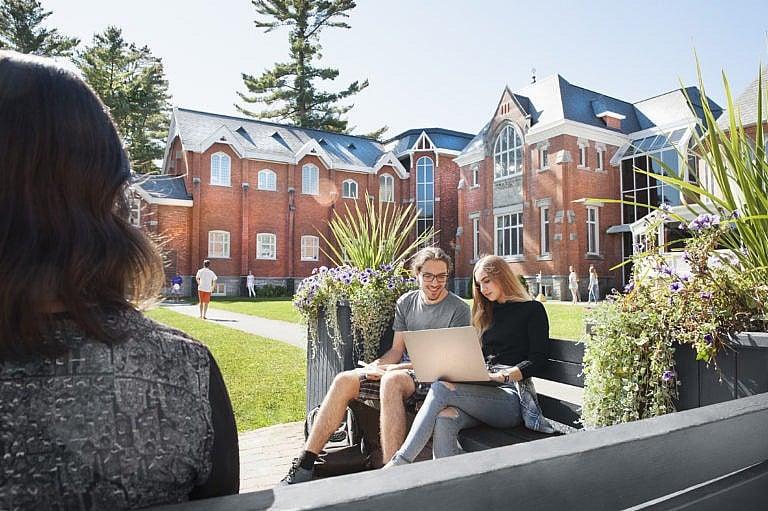How these four pillars are transforming the student life experience at Bishop’s University
Growth, curiosity, equity and community: a holistic approach to supporting students in and out of the classroom.

Photo: Bishop’s Univerity
Share

Nestled in the picturesque city of Sherbrooke, Que., you’ll find Bishop’s University—a beautiful campus with welcoming arches adorned with brick stone. “It’s so hard to capture what it’s like because it’s an experience that is magical in the sense that you’re surrounded by nature,” says Enzo Evangelisti, who graduated from Bishop’s in 2022 and has returned as residence life coordinator.
Located on 550 acres at the junction of the Saint-François and Massawippi rivers in the province’s Eastern Townships, the liberal arts university, founded in 1843, also boasts some stunning 19th century architecture alongside a futuristic, newly-renovated and updated Library Learning Commons with open spaces for collaboration and socializing.
With fewer than 3,000 full-time students—many of whom live on campus—Bishop’s University is renowned for its close-knit community of students, faculty and staff. “There’s a deep-rooted connection that’s fostered by the campus itself and the people who work here,” says Evangelisti. “It’s a combination of factors that creates this unique experience that’s so hard to explain.”
Katie Bibbs, the academic facilitator in Student Services, agrees. “It brings these young people together with faculty and staff who are so committed to the student experience in a really interesting incubator of shared passion, shared curiosity and shared desire to really make this a fulfilling experience.”
“When students come to a smaller liberal arts institution, they expect a more holistic experience,” she explains. This year, the school is amplifying that experience with a curricular approach to student affairs—an innovative framework that is growing in popularity across North America. The curricular approach broadens the whole concept of education to include intentional academic, personal and professional learning, outside the classroom, in-residence and beyond.
“We’re operating with the lens that we are educators too,” adds Bibbs. “We’re here to serve the student experience, to help them grow as human beings so that the emphasis is not just on the transcript, but rather on the entire student, so that when they leave, they leave a whole, fulfilled human being who feels like they have really grown because of their experience on campus.”
To that end, Student Affairs identified four learning aims rooted in the university’s culture, values and mission. The first is to support the personal growth of the student because, as Bibbs notes, “it’s their definition of success that matters–not mine, not their profs’.” That may involve, for example, helping students learn how to advocate for themselves or resolve conflicts—essential life skills to be sure, but ones that aren’t typically an intentional part of the university experience.
The next is fostering curiosity. When different factions of the Bishop’s community were asked what their hopes were for students when they graduate, Bibbs says, having curiosity was one of the top answers. Then, there is the goal of helping to develop equity-minded human beings, Bibbs says. “I think that’s been a real catchphrase in the last couple of years, but it really comes from the heart, I think, for so many,” she adds. “In the Student Affairs Department, we’re trying to support a more inclusive and equitable environment for our students to live in and build community in.”
And finally, there’s community engagement. “It’s about developing that sense of self and identity,” Bibbs says, “so that they may then go and engage and make those community connections and then contribute to that community in a positive and meaningful way.”
Click here for more information on open house dates during the 2022-2023 academic year.